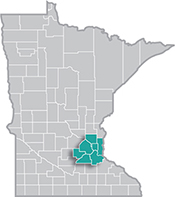 The Minneapolis-St. Paul metropolitan area is a national leader in finance, advanced manufacturing, agriculture and retailing.
The Minneapolis-St. Paul metropolitan area is a national leader in finance, advanced manufacturing, agriculture and retailing.
Medical devices, electronics and processed foods are strong suits recognized globally.
Want the freshest data delivered by email? Subscribe to our regional newsletters.
11/13/2019 1:00:00 PM
Tim O'Neill
On Monday, November 11, Veterans Day will be observed throughout the United States to celebrate the service of all U.S. military veterans. As an appreciation to those who have served or are currently serving, this month’s blogpost will focus on veterans in the Twin Cities region.
As of 2018 there were about 2,771,285 people 18 years of age and older living in the Minneapolis-St. Paul Metropolitan Statistical Area (MSA). An estimated 6.0 percent of that population, or 166,768 people, were veterans (Table 1).

Recent data from the 2018 American Community Survey (ACS) continues to show stark differences for veterans in the Minneapolis-St. Paul MSA when compared to the non-veteran population. One, the veteran community is much older. As of 2018, over half (53.5 percent) of veterans reported being 65 years of age and older. Of the nonveteran population over the age of 18, only 16.0 percent reported being 65 years of age and older.
Two, ACS data reveals that veterans in the Minneapolis-St. Paul MSA are much more likely to have a disability than the non-veteran population. As of 2018, over one-in-four veterans in the region reported having any disability, compared with about one-in-10 for the nonveteran population. Along with reported disabilities, many veterans may also live with mental and behavioral health challenges, have difficulty finding employment, have financial hurdles, or other issues. Minnesota Service CORE and the Minnesota Department of Veterans Affairs (MDVA) continue their unique partnership with the goal of helping veterans with the challenges above.
According to the U.S. Bureau of Labor Statistics’ Current Population Survey (CPS), veterans at the national level are employed in the following occupational groups:
While this data is not available at the Metropolitan level, it highlights the fact that veterans find employment within every occupational area once they enter the civilian labor force. More than 20 percent, however, find work within professional and related occupations (i.e., information technology, engineering, architecture), with nearly another 20 percent finding work in management, business, and financial operations occupations. This points to the fact that veterans have a wealth of skill sets that employers across every industry sector can benefit from. This is especially important as the Twin Cities’ labor market remains tight.
DEED has employment services specifically targeted at veterans, with the aim of connecting employers searching for quality candidates and veterans searching for life-sustaining career opportunities. Check out more resources online here.
Whether you’re an older or a younger veteran, have a high school diploma or higher education, or have a disability, there is a place in Minnesota’s labor market for you. Check out the many resources for assisting veterans with finding the right career online:
Contact Tim O'Neill at 651-259-7401